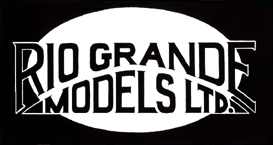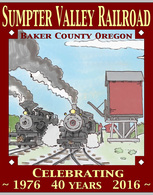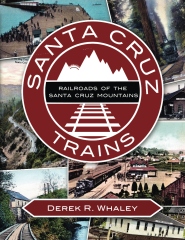

Colusa & Lake Railroad.
By Andrew BrandonS ituated on a bend of the Sacramento River, the town of Colusa was originally founded as “Salmon Bend” in 1850. In 1851 the town was renamed Colusi after the local tribe of Native Americans, the Colus, who lived on the west side of the river. In 1854 it was renamed Colusa (along with the county) by an act of the state legislature and subsequently became the County Seat. Located centrally in the upper Sacramento Valley, the Colusa region is largely used for agricultural products and livestock. During the mid 19th century the inability to ship these products, except by way of steamboat service which arrived in 1850, hindered the development of the county.
Several plans to bring a railroad to Colusa County were proposed during the 1860s, but none of them came to fruition. In 1869 the California Pacific Railroad (Cal-P) began building north from Davis toward Knight’s Landing. Upon reaching Knight’s Landing in 1873, the Cal-P established steamboat service to Colusa. On June 23, 1876 the Northern Railway, a Central Pacific Railroad subsidiary, reached Williams. When construction resumed in 1878, the railroad continued building north towards Willows, bypassing Colusa.
Shortly after the Northern Railway arrived, the town of Williams petitioned to have the county seat relocated to there. The possibility of losing the county seat caused an uproar in Colusa and the residents proposed a railroad of their own. Back in 1876, the residents of Colusa successfully petitioned the State Assembly for permission to issue bonds for a railroad, but they had not come up with a successful proposal until 1885. In June 1885 subscription papers for a railroad began circulating town and local businessmen subscribed to the bonds.
On July 4th Colusa celebrated in a special way, the first stake of the survey was ceremoniously driven at the edge of Colusa. A few days later the San Francisco Chronicle mistakenly stated that the railroad would build to Williams. Two days later they ran a correction from Colusa stating: "there has at no time been any idea of building the road to Williams”. 1 On July 17, 1885, the Colusa Railroad filed for incorporation with was organized with E. A. Harrington, W. P. Harrington, E. W. Jones, J. B. Cooke and W. D. Dean as directors and B H. Burton, treasurer. The chosen survey utilized the right of way from an existing county highway, a distance of 9.7 miles to a point on the Northern Railroad between Williams and Maxwell. Located on 40 acres of land donated by local farmer J. W. Potts, the new station was called “Pott's Station” or “Pottsborough”. A few months later it was renamed “Colusa Junction”. 2
Initial bids for contractors were put out on September 10th. After receiving no suitable bids, the company decided to take the effort up themselves. Grading began on September 24th, when 40, 4 horse teams put to work. Through October progress was rapidly made on the grade. That month the contract for trestle construction was given to McMahon & Co. of San Francisco. 3
The first locomotive, a 2-4-2T named “Colusa” was built by H.K. Porter in late 1885, arriving in Sacramento on November 26. A few days later the locomotive was moved up the Sacramento river on a barge behind the steamboat “Dover”. George Ogden, a native of the county was selected as the railroad's first engineer. The residents of Colusa seized upon the moment and held an impromptu celebration in the locomotive's honor on December 8. 4
Construction continued through the winter of 1885-1886 with few obstacles. In January 1886 the railroad reached Hopkins Slough, where the first trestle was constructed. 5 A second trestle, nearly a mile long was constructed over the lowest point of the valley floor. A large arcade depot built on Main street was completed in February 1886. On March 5, 1886 the first construction train ran over the line, a month later the railroad ran the first public excursion over the route. Regular passenger service to Colusa Junction began on April 30th.
Talk of extending the line continued in the papers. The Sacramento Board of Trade became interested in the possibility of an extension into the foothills. In late April they sent two trade members and the City Engineer as part of a committee to follow the route. In May the committee returned to submit their findings. The route would have taken the railroad from Colusa Junction, northwest 9 miles to Stone Corral, then west one mile through an easy pass into the Antelope Valley and the town of Sites. There the route turned south through valley for 10 miles before turning to the west for 3 miles. From there a tunnel (800 to 1000 feet long) was proposed and the route would have climbed the mountains to a summit, one mile from Leesville at an elevation of 1450 ft. It was then proposed to continue south to Lower Lake with a branch to Bartlett Springs. From Lower Lake the route was said to extend into Lakeport and then on to the Pacific Ocean. 6
On June 8, 1886 a new company, the Colusa & Lake Railroad was incorporated to build the extension west into the Antelope valley. Later that month the Colusa Railroad ordered their second locomotive, a 4-4-0 from the Baldwin locomotive works named “Harrington”. Construction of the line continued through the summer and Sites was reached on September 29, 1886. The Colusa Railroad and Colusa & Lake Railroad were consolidated on November 27th under the name Colusa & Lake Railroad. On December 18th the railroad officially opened for service to Sites with free excursions from Colusa to Sites.
Initially the railroad's primary focus was the passenger service from Colusa Junction to Colusa. When the route opened as far as Sites, tourists headed for Lake County became an important source of revenue. In April 1887 the Railway Mail Service Superintendent inspector toured the line and soon afterward the railroad was given a mail contract from Colusa Junction to Sites. 7 In June, stages destined for Bartlett Springs were connecting at Sites, now the shortest route. The railroad also added a later connecting train, allowing travelers leaving San Francisco at 4:30PM to arrive in Colusa by 10:30 PM the same day. On Sundays and holidays the railroad operated excursions across the line, these trips were the only time full passenger trains made the complete trip from Colusa to Sites.
A daily mixed train (freight and passengers) operated from Colusa to Sites and served the sidings and warehouses along route. Wheat, Barley and Sheep where the primary freight hauled by the railroad. In 1887 the county began promoting the region as an agricultural paradise. That same year saw the introduction of the Holt Brothers' “Combined Harvester” to the Sacramento valley. Holt's harvester was noted for the ability to thresh and sack the grain, reducing the number of machines and animals required to work the valley. By 1890 over 80% of the freight tonnage hauled on the railroad was wheat.
The 1890s would bring a new source of revenue to the railroad. Sandstone was a prominent feature along the line and two large faces in Stone Corral canyon became home to a pair of quarries. The first to open was the O’Neil and Abbot quarry, incorporated in November 1891 on land leased from John Sites. 8 Located there was a face of metamorphic sandstone, 8 to 10 feet thick at a slope of 55 degrees. In the first year of operation, 20,000 cubic feet of sandstone were produced. In time the O’Neil and Abbot quarry would become the Colusa Sandstone Company, the largest freight producer on the line. The second quarry, the McGilvrey Sandstone Company opened to the south of Colusa Sandstone in 1900. The quarry was located on a face 45ft thick, 230ft wide and 220ft tall. A short spur was built across Stone Corral creek for loading cars.
Sites sandstone gained acclaim after the San Francisco earthquake as buildings constructed with it came through the 1906 Earthquake virtually undamaged. State reports indicate that the quarry output reached its peak by 1906, when the quarries shipped 302,813 cubic feet of stone, over 1/3rd of all stone output in the state. 9 The sandstone saw use in many prominent buildings in San Francisco, including the Ferry Building, the Flood, Kohl, and Spreckels buildings, the St. Francis Hotel, and the Emporium. The stone also found use abroad in the Alexander Young Hotel in Honolulu, Carnegie libraries and other buildings in Colusa, Marysville and San Mateo.
At the western terminal of the railroad in Sites, a hotel was built to accommodate the passengers destined for Lake County. A large warehouse for grain storage was also constructed next to the depot. A yard with and short wye for turning locomotives was located there. At the western end of the yard was a small engine house. In August 1895 the engine house in Sites burned causing considerable damage to the locomotive #3, the pride of the railroad, which had been stored inside. At around 1900 the Sites Hotel burned down and was replaced with a smaller depot.
In Colusa the railroad operated a compact facility in on the corner of Main and Eighth streets. On the south side of the arcade depot and freight house, the railroad constructed single stall engine house. In 1886 a turntable was added. As the railroad continued to grow the engine house was expanded. By 1897 there were 4 stalls and two additional tracks were covered by an extended roof from the western wall of the engine house. This confined arrangement proved to be hazardous and a special fence was constructed on the turntable to prevent passengers from falling in. Just east of the railroad facilities a branch left the yard and climbed up on the levee to reach the Sacramento Transportation Co. and Farmers’ Transportation Company warehouses along the river in Colusa. From there grain and stone products were transshipment on the river.
On October 28, 1909 the railroad suffered its first wreck when 4-4-0 #2 and train derailed near Parkinson’s, 5mi (7km) west of Colusa. In February 1910 the railroad purchased an additional 4-4-0 from the South Pacific Coast Railroad and it became locomotive #4. 10 The railroad suffered the biggest accident to occur on the line in 1913 when a train lead by #2 derailed on the trestle between Colusa and the Junction 3 miles west of Colusa. The damage was severe enough that #2 was put out of service permanently.
In 1911 the Southern Pacific incorporated the Colusa and Hamilton Railroad and began construction in 1912. The new line reached Colusa in June 1913, rendering the narrow gauge passenger service obsolete. On June 13, 1913 the Northern Electric Railway (the predecessor of the Sacramento Northern) opened its line from Marysville to Colusa, operating 9 trains daily, which immediately diverted the narrow gauge's traffic. Later in 1913, another nail was driven into the railroad's coffin when a passenger train hauled by #2 derailed on the long trestle between Colusa and Colusa Junction; the locomotive was never repaired.
Passenger service was discontinued on August 5, 1914. The stated reason was track safety; however, the management continued to operate freight service and received permission from the California Railroad Commission to suspend operations effective May 1, 1915. Ownership of the railroad went to the Bank of Colusa and later to a person connected with the Southern Pacific. A survey was quietly made of the line by the SP’s Sacramento Division Engineering Department This new alignment would connect to Maxwell directly, bypassing the entirety of the former C&L route and reconnecting with the route near Mills. The Southern Pacific went so far as to send photographers out to document the line, but the plan was shelved.
By the end of 1916 scrappers began disassembling the Colusa and Lake. Two passenger cars, several freight cars, spare trucks, and rail were sold to J. E. Sexton of Eureka-Nevada Railroad. Several boxcars, the coach, and a baggage were loaded up and shipped to Nevada.11 What remained of the railroad was sold to the United Commercial Company and torn up for scrap through 1918. In October 1918 the United Commercial Company listed the remaining equipment for sale: 2 Baldwin locomotives and several flatcars.12 Locomotive #4 and several flatcars were purchased by the Imperial Gypsum & Oil Co. in 1921 (Later Pacific Portland Cement Co., then U.S. Gypsum Co.) for use building a railroad out of Plaster City.
The former route of the Colusa and Lake Railroad from Colusa to Cortena was eventually graded back into a county road called Lurline Rd. The station Colusa Junction was renamed Cortena on March 9, 191713 and the small depot there remained in place until 1935. Today Cortena is still a station on the California Northern Railroad, but no recognizable traces from the Colusa & Lake days remain. The roundhouse on the corner of Main and 8th remained in place and used by W. C. Stokes as a machine shop for many years until it was abandoned. The structure remained in place, slowly deteriorating until 2009 when it was deemed unsafe and finally torn down.
2. Colusa Railroad Survey Map, 1885. California State Archives.
3. Sacramento Daily Union, Volume 54, Number 47, 15 October 1885
4. Daily Alta California, Volume 39, Number 13052, 8 December 1885
5. Rogers, Justus H. Colusa County. Orland California, 1891. pg 218.
6. Sacramento Daily Union, Volume 55, Number 74, 18 May 1886
7. Daily Alta California, Volume 42, Number 13743, 17 April 1887
8. Report of the State Mineralogist. California State Mining Bureau, 1892
9. Rock Products - Stone Edition, Vol. VII, Number 7. February 5, 1908
10. Strapac, Joseph A and Diebert, Timothy SP Steam Locomotive Compendium Shade Tree Books, 1990. ISBN-10: 0-9307-4212-5
11. Sacramento Union, Number 54, 24 December 1916
12. Pacific Marine Review, October 1918
13. ICC Valuation Map: "Colusa Junction" 1917.
Bibliography
"Colusa & Lake Railroad", The Western Railroader, 37, issue 405 (1974).
Hilton, George W. American Narrow Gauge Railroads. Stanford: Stanford University Press, 1990. ISBN 0-8047-2369-9.
Rogers, Justus H. Colusa County. Orland California, 1891.
Bender, Henry. "Colusa & Lake Railroad" (2015).
Vain, Ronald. "Colusa & Lake", The Lark, #58 (May 18, 1992).
Morgan, David J. It's Lonely at the Top: Narrow Gauge Logging in California's Lake County Lake County, 2008.
Reference Material Available Online:
Maps.
The Route of the Colusa & Lake Railroad for Google Earth.
by Andrew Brandon.
ICC Valuation Map, Central Pacific Railroad, Northern Ry. V54, Sheet 14.  4.8MB
4.8MB
National Archives, College Park Maryland.
ICC Valuation Map, Central Pacific Railroad, Northern Ry. V54, Sheet S14.  4.5MB
4.5MB
National Archives, College Park Maryland.
Photographs.
Collected Colusa & Lake Photographs.
Images collected from private collections, libraries and historical societies.
Articles.
The Totman Patent Grass/Weed Burner.
Railroad Equipment For Sale, United Commercial Company. - Pacific Marine Review, October 1918.
Includes two small photos of former C&L equipment in San Francisco prior to being sold to Imperial Valley Gypsum and Oil Corporation.
Colusa Junction [pg 289] (Brief Description). From: Over the range to the Golden Gate.
Colusa Sandstone and McGilvrey Quarries.
From: California State Mining Bureau. Bulletin Issue #38, January 1908.
Descision #2324. In the Matter of the Application of the Colusa & Lake to Discontinue Operation.
Descisions of the Railroad Commission of the State of California, Vol. 6, 1915.
Descision #3131. Authorizing the construction of a highway crossing at grade over the tracks of the Colusa and Lake Railroad.
Descisions of the Railroad Commission of the State of California, Vol. 9, 1916.
Owen Sullivan vs. The Colusa and Lake Railroad Company. Report of the Board of Railroad Commissioners of California. 1901.
Complaint about tariff rates.
Manuscripts.
Correspondence regarding charges on less than carload transloading.  0.34MB
0.34MB
California Public Utilities Commission Case No. 117: Documents.
From the California State Archives.



